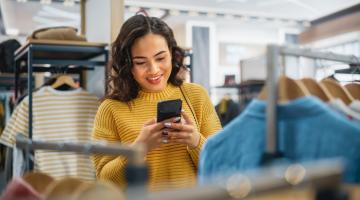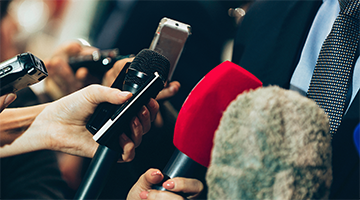

It’s the time of year when things are always rocking at Barnes & Noble College’s 770 physical bookstores and 600 virtual stores at colleges and universities nationwide. But this year, the retailer — which is a completely separate company from bookseller Barnes & Noble but licenses the use of the name — is beginning to totally upend its business model.
The changes are many — from how books and classroom supplies are distributed to a new focus on student physical health and mental well-being in the products the campus stores sell. NRF contributor Bruce Horovitz spoke with Jonathan Shar, president of the company, about how far these changes are going and what’s next.
What’s new in back-to-college offerings at Barnes & Noble College this year?
One thing that’s changing is our emphasis on healthier snacks on the convenience side. We have introduced something we call Recharge U, which includes snacks like trail mix or nuts versus traditional snacks like chips or candy. It’s new for us this back-to-school and shows signs of something that’s meeting consumer demand.
How else is this better-for-you trend showing up in your stores?
What’s really new and interesting is what we call “Be Well. Be You. by Barnes & Noble College.” It’s a curated wellness collection for body and mind targeted at supporting student well-being.
What kinds of products are sold under the Be Well, Be You umbrella?
Things like aromatherapy products. Personal care products like warm, plush toys for calming called Warmies, which are scented and warm up. And reading materials like “The Little Book of Mindfulness.”

What’s driving all this mindfulness?
Academic institutions are increasingly supporting students from a well-being and mental health perspective. Offering these items makes the college bookstores more relevant and more impactful in supporting their customers.
Are any of these items exclusive to Barnes & Noble College in the college market?
There’s a new company that Melissa Bernstein (co-founder of Melissa and Doug Toys) has started called Lifelines. She’s passionate about mental health for students. They have come out with a collection of sensory immersion tools to support the body, including scented oils like lavender, diffusers and scent-infused grinding stones.
This is clearly not your grandfather’s college bookstore.
At the highest level, the bookstore used to be a place to get books, sweatshirts and backpacks. It’s evolved into a place that unlocks great consumer experiences. It’s about enhancing the student experience and supporting the overall well-being of the campus.
Books aside, it sounds like all the other “stuff” is increasingly important to your bottom line.
Every year, the industry and our role within the higher education industry is changing. Things are moving more digital and more omnichannel. At the same time, our role in providing lots of products, goods and experiences for other uses is growing. That includes sales of emblematic items, like water bottles and sweatshirts with emblems of the university.
How are emblematic sales evolving?
With a more diverse range of offerings. We now offer lines of price points that we call good, better and best. For example, we not only carry notebooks with the school emblem, but (less expensive) non-emblematic notebooks. After all, our customers come from diverse economic statuses. We have to be a solution for all customers.
What’s an example of your emblematic sportswear diversity?
Well, we have classic sweatshirts from Champion to Peter Millar. The prices can vary by $50.
Are each of your college bookstores operated the same way?
Every store is operated in a different way. We try to tailor to the local school. The local campus culture and the space provided help to determine how we operate the store. Our store managers are as aligned with the campus as they are with Barnes & Noble College.
Check out the back-to-school and back-to-college research on consumer spending this season, conducted by NRF and Prosper Insights & Analytics.
How have sales of books — particularly textbooks — changed at Barnes & Noble College?
The textbook side of retail has seen a model shift. We’ve created a new model for distribution that we call the First Day Complete. It’s an affordable subscription program. It’s now live at 157 of our campus stores.
How does it work?
For one flat price per term, all of your books and required supplies for your classes are (automatically) provided. All you have to do is walk into our store and pick up the box or bag waiting for you.
How is it paid for?
In some cases, it’s charged through tuition or a course fee. It’s a concierge subscription service. Everything is prepackaged. The price points are 35% to 50% less than the ala carte model.
This sounds like a huge change.
This is a massive game-changer. It’s a large bulk discount program. It addresses affordability, access and convenience, which today’s student shopper is demanding. It’s changing the role of the store. It’s the first model change in support of textbooks and course materials in the past 40 years. It will have a massive impact on back-to-school this year and the role of the retail store on the college campus.
How will this program evolve?
Over the next five years, it will be in all of our stores. The fees and costs need to be built into tuition or course fees. Students have the option to opt in or out. It’s almost like the college meal plan. We are working with the schools to build this subscription service program.
So, no more hours online — or in the bookstore — figuring out what books you need?
You do nothing but pick up your materials. You no longer have to do things like compare if Amazon has a better price or if the textbook you order is the right edition. It’s all taken care of up front. All you do is scan a QR code on the phone, then go pick up your books.

What are some schools now using this subscription model?
The University of Connecticut. Tulane University. University of North Carolina Greensboro. Providence College. Lehigh University.
What about digital textbooks?
We deliver that through the learning management systems at the institutions.
What’s the breakdown now of your hard copy textbook sales versus digital textbooks?
We still sell a majority of physical textbooks but it’s getting closer to 50/50, and it will flip.

Any new technologies that you’re using in your stores?
Last year we introduced a pilot self-checkout program at Notre Dame (for non-textbook items). And we’re expanding it to Penn State.
How do you respond to the transparency and sustainability requirements of this generation?
For transparency, we have a price match guarantee in our subscription model. If you find a better price for the exact same book, we’ll provide a refund. As for sustainability, it’s campus-by-campus. We align with all state and county rules and regulations in bags and packaging as well as campus sustainability efforts.
What about your technology sales?
One trend we’re seeing is a growth in sales of tech accessories like wireless speakers and noise-canceling headphones.
How does your business evolve through the school year?
At the beginning of the academic year, it’s all about textbook distribution. The balance of the year, it transitions to emblematic clothing, tech items and convenience items. At the end of the year, it shifts to graduation caps and gowns.
What’s raising eyebrows among students this year?
Well, many are surprised that we’re selling offering things like aromatherapy. They wonder: What’s that doing in a college bookstore?




